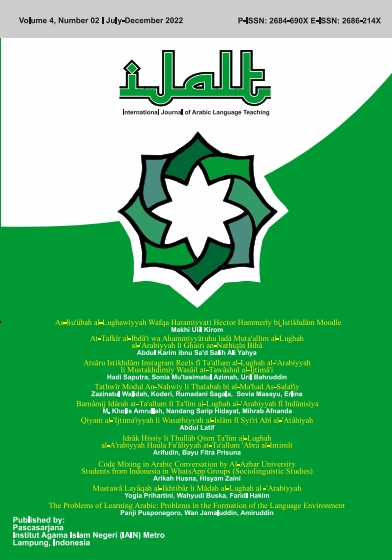Problems in the Formation of Language Environment in Learning Arabic
DOI:
https://doi.org/10.32332/ijalt.v4i02.5027Keywords:
Environmental; improve; supportAbstract
This article aims to discuse about the Arabic-speaking education at the Islamic boarding school Al Ghifariy of East Lampung. Many students use Javanese and do not use proper grammar. This study aims to find out how to solve the implementation of an environmental program in Arabic and the problems there, as well as the supporting and inhibiting factors in the implementation of language activities. By using The descriptive analysis method, sample of data collected by interview, observation and documentation. The results of the data analysis show that the students lack the desire to learn Arabic, due to the lack of support from those closest to them, an environment that does not support progress in educational attainment and students lack self-confidence. Attempts to solve it the school is trying to improve the skills of teachers by involving them in educational trainings from the government.
References
Al-Rawashdeh, BasmaOdeh Salman. “Arabised Terminology Issue in the Holy Quran from a Modern and Critical Perspective.” International Journal of Linguistics 6, no. 4 (15 Agustus 2014): 116. https://doi.org/10.5296/ijl.v6i4.6146.
Amalina, Nurul Hidayatul, dan Muhammad Nashirudin. “ANALISIS PROSES PEMBELAJARAN BAHASA ARAB PADA TINGKAT TSANAWIYAH DI PONDOK PESANTREN TA’MIRUL ISLAM.” Jurnal Tatsqif 15, no. 2 (17 Desember 2017): 173–90. https://doi.org/10.20414/jtq.v15i2.7.
Aman, Moh. “BAHASA ARAB DAN BAHASA AL-QUR’AN.” Jurnal Kajian Islam dan Pendidikan Tadarus Tarbawy 3, no. 1 (30 Maret 2021). https://doi.org/10.31000/jkip.v3i1.4256.
Arsyad, M. Husni. “Metode-Metode Pembelajaran Bahasa Arab Berdasarkan Pendekatan Komunikatif Untuk Meningkatkan Kecakapan Berbahasa.” Shaut al Arabiyyah 7, no. 1 (27 Juni 2019): 13. https://doi.org/10.24252/saa.v1i1.8269.
Dj, Napis. “Linguistik dengan I’rab Al-Qur’an dan Posisi Bahasa Arab dalam Memahami Al-Qur’an,” t.t., 17.
Fathi Hidayah. “Kearbitreran Bahasa Arab dan Urgensi Mempelajarinya dalam Pandangan Linguis Arab Klasik.” Studi Arab 10, no. 2 (30 Desember 2019): 101–1016. https://doi.org/10.35891/sa.v10i2.1855.
Fitzmaurice, Garrett M., dan Caitlin Ravichandran. “A Primer in Longitudinal Data Analysis.” Circulation 118, no. 19 (4 November 2008): 2005–10. https://doi.org/10.1161/CIRCULATIONAHA.107.714618.
Gintsburg, Sarali. “Arabic Language in Zanzibar: Past, Present, and Future.” Journal of World Languages 5, no. 2 (4 Mei 2018): 81–100. https://doi.org/10.1080/21698252.2019.1570663.
Guillaume, Jean-Patrick. “Les discussions des grammairiens arabes à propos du sens des marques d’I՟rab.” Histoire Épistémologie Langage 20, no. 2 (1998): 43–62. https://doi.org/10.3406/hel.1998.2711.
Hasmam, Aisah, Nik Mohd Rahimi, Nik Farhan Mustapha, dan Mohd Yusri Kamarudin. “Word Selection in Teaching Arabic Vocabulary for Lower Secondary Level.” Creative Education 07, no. 03 (2016): 387–95. https://doi.org/10.4236/ce.2016.73038.
Hayrettin, TUN Ccedil EL. “The Relationship between Self-Confidence and Learning Turkish as a Foreign Language.” Educational Research and Reviews 10, no. 18 (23 September 2015): 2575–89. https://doi.org/10.5897/ERR2015.2445.
Hidayah, Fitriatun. “PENGARUH LINGKUNGAN BERBAHASA TERHADAP KETERAMPILAN BERBICARA BAHASA ARAB BAGI SISWA KELAS X MA PONDOK PESANTREN USWATUN HASANAH CEMPAKA PUTIH DESA AIK DAREK KECAMATAN BATUKLIANG,” t.t., 15.
Ismail, Taufik Bin, Muhammad Sabri Bin Sahrir, dan Aliff Fahmi Bin Abdullah. “ISTIRATIJIYAT AL-TA’ALUM AL-MUBASYIR LADA AL-THALABAH AL-MUTAKHASHISHIN FI AL-LUGHAH AL-‘ARABIYAH BI ISTIKHDAM BARNAMAJ ATLAS.ti.” Arabiyat : Jurnal Pendidikan Bahasa Arab dan Kebahasaaraban 3, no. 2 (28 Desember 2016): 267–81. https://doi.org/10.15408/a.v3i2.3333.
Kapoh, Ruty J. “BEBERAPA FAKTOR YANG BERPENGARUH DALAM PEROLEHAN BAHASA” 4 (2010): 9.
Kurniawati, Ijah. “MANAJEMEN PESANTREN UNTUK MENINGKATKAN KETERAMPILAN BERBICARA BAHASA ARAB DI PONDOK PESANTREN DINIYYAH PASIA KABUPATEN AGAM,” t.t., 7.
Noor, Zaid Arafat Mohd, Nik Mohd Rahimi Nik Yusoff, Irma Martiny Md. Yasim, dan Mohd Yusri Kamarudin. “Foreign Language Vocabulary Learning Strategies in Malaysia.” Creative Education 07, no. 03 (2016): 428–34. https://doi.org/10.4236/ce.2016.73042.
“Nwf.com: أساسيات منهجية البحث في العلوم الإنسانية: فهد خليل زايد: كتب.” Diakses 26 April 2022.
https://www.neelwafurat.com/itempage.aspx?id=lbb150778-112267&search=books.
“Paradigm Shift: Understanding and Implementing Change in Second Language Education.” Diakses 26 April 2022. http://www.tesl-ej.org/wordpress/issues/volume5/ej17/ej17a1/.
“Qualitative Research: A Guide to Design and Implementation, 4th Edition | Wiley.” Diakses 26 April 2022.
https://www.wiley.com/enus/Qualitative+Research%3A+A+Guide+to+Design+and+Implementation%2C+4th+Edition-p-9781119003618.
Rachman, Yaris Eka. “Faktor-Faktor Penghambat Dalam Memahami Bahasa Arab.” EL-IBTIKAR: Jurnal Pendidikan Bahasa Arab 10, no. 1 (16 Juni 2021): 39. https://doi.org/10.24235/ibtikar.v10i1.7725.
Rosidi, Ahmad. “MOTIVASI SANTRI DALAM MENGHAFAL Al-QUR’AN,” t.t., 35.
Sholikhah, Amirotun. “STATISTIK DESKRIPTIF DALAM PENELITIAN KUALITATIF.” KOMUNIKA: Jurnal Dakwah dan Komunikasi 10, no. 2 (1 Januari 1970): 342–62. https://doi.org/10.24090/komunika.v10i2.953.
Taubah, Miftachul. “Menciptakan Bi’ah ‘Arabiyah di Lingkungan Universitas yang Multikultural,” t.t., 10.
“The-Logical-Problem-of-Foreign-Language-Learning.pdf.” Diakses 26 April 2022.
https://www.researchgate.net/profile/Robert-Bley-
Vroman/publication/240412239_The_Logical_Problem_of_Foreign_Language_Learning/links/55671a8008aeccd777378100/The-Logical-Problem-of-Foreign-Language-Learning.pdf.










